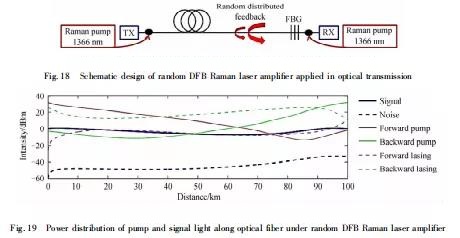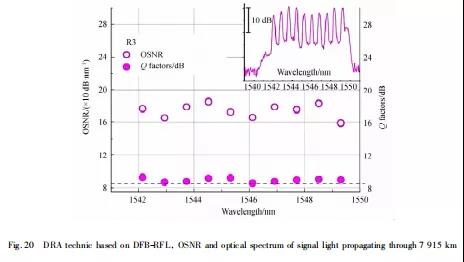
Ultra-long distance non-relay optical transmission has always been a research hotspot in the field of optical fiber communication. The exploration of new optical amplification technology is a key scientific issue to further extend the distance of non-relay optical transmission. DRA technology based on DFB-RFL provides a new optical amplification method for long-distance non-relay optical transmission. In 2015, ROSA P et al. studied the characteristics of DRA based on DFB-RFL applied to Wavelength Division Multiplexing (WDM) transmission systems. Figure 18 is a schematic diagram of the structure of the amplification scheme. The 1365 nm double-ended pumping structure is adopted, and only a 1 55 nm FBG is added to the signal receiving end, so that the main energy distribution direction and signal light transmission direction of the lasing 1455 nm random laser On the contrary, this can effectively reduce the relative intensity noise of the random laser Raman pump light transferred to the signal light. On the other hand, the use of a double-ended pump structure makes the power distribution of the signal light along the fiber relatively flat (Figure 18), thereby improving the signal-to-noise ratio of the system. The simulation results of a 100-channel 50 km-long WDM optical transmission system with 25 GHz channel spacing (Figure 19) show that when this amplification scheme is used, the maximum signal-to-noise ratio difference between channels is only 0.5 dB. It has excellent performance in DWDM system.

In 2016, TAN M et al. applied the DFB-RFL-based DRA technology shown in Figure 18 to 10 × 116 Gb/s DP-QPSK WDM, and compared this scheme with traditional Raman lasers (where both ends of the fiber are placed). 1455 nm FBG) DRA scheme and the traditional second-order Raman amplification scheme (1365 nm and 1455 nm pumping at one end of the fiber at the same time) transmission performance. The results show that DRA technology using DFB-RFL can achieve the longest transmission distance, reaching 7 915 km. Figure 20 shows the optical signal-to-noise ratio (OSNR) and spectrogram after 7 915 km of signal light transmission using DFB-RFL DRA technology. It can be seen that the OSNR fluctuations between channels are small and uniform Above the Q threshold. The above experimental results all show that DRA technology based on DFB-RFL has great potential and advantages in ultra-long-distance non-relay optical transmission.

Copyright @ 2020 Shenzhen Box Optronics Technology Co., Ltd. - China Fiber Optic Modules, Fiber Coupled Lasers Manufacturers, Laser Components Suppliers All Rights Reserved.